Raiders of Scythia - A Solo Review
27 Jul 2021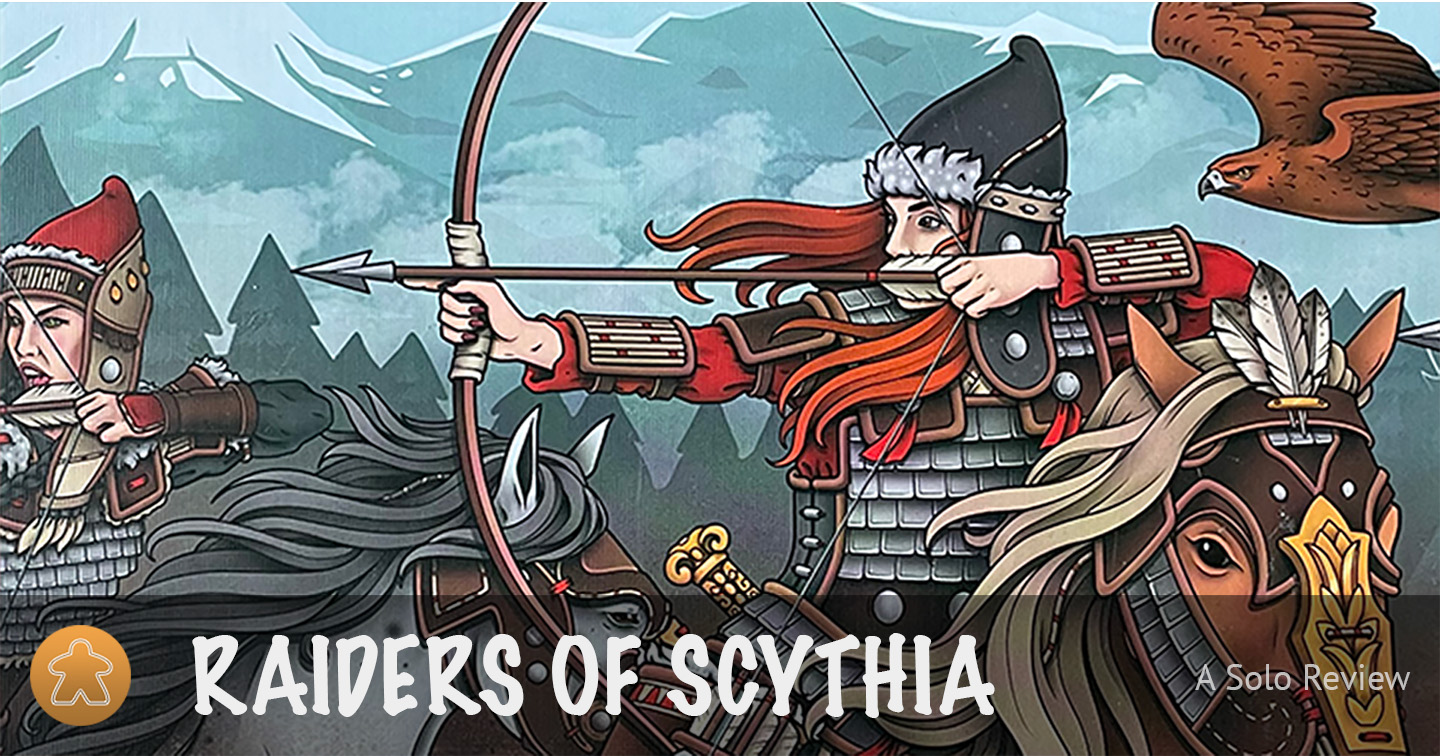
Look at those Cimmerians, Assyrians, Persians and Greeks with all their lands and their power and their wealth. Look at them underestimating the fierce and skilled warriors of Scythia. Once they hear the hoofbeats of your war horses and the shrieks of your trained eagles it will already be too late; they’ll never know what hit them.
Will you be the warlord who ends the Cimmerian, Assyrian, Persian and Greek dominance? There’s only one way to find out.
Name: Raiders of Scythia
Designer: Shem Phillips
Publisher: Garphill Games
Game type: worker placement, contracts, hand management
What is Raiders of Scythia?
In Raiders of Scythia you take up the role of a Scythian warlord. You will build up a crew of raiders, equip them with fierce horses and eagles, and set out to Cimmeria, Assyria, Persia and ultimately Greece to raid and plunder the various settlements there. Raiding gives you victory points, loot and uncovers quests. These quests can be completed by turning in plunder, giving you more victory points.
How does it play?
Raiders of Scythia is a worker placement game with a twist. There are two things it adds to the mix to make things a lot more interesting and fun.
The first thing is that you only ever have one worker. On your turn you use your worker for one of two things: working or raiding.
Working means taking an action in your Scythian village. These actions typically give you resources like provisions, silver, cards or kumis (fermented horse milk which gives your crew extra strength, yummy!) or allow you to spend resources to build and train your crew. When you use your worker to… well, work, you place it on an action, you execute that action, and then you get to pick up a different worker and execute that action as well.
Raiding on the other hand also has you placing your one worker, but one of the things you get, in addition to victory points and plunder, is a different and usually more powerful worker.
That’s the second thing Raiders of Scythia adds to the usual worker placement mechanic: workers of different types. You start with a basic blue worker, but by doing raids you can get grey and red workers. Some of the worker actions in the village give better or different rewards based on the color of the worker, and some actions can only be done with specific colors.
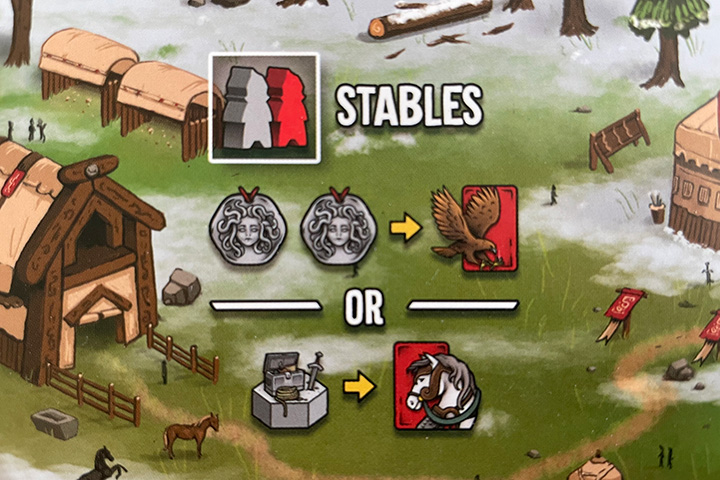

Getting to do two actions every turn (but one of those actions needing to have a worker on it at the start of your turn) in combination with the different types of workers really spices things up and forces you to think and plan ahead. You may want to get provisions and silver on your current turn, but if you pick up the blue worker that gives you silver, you can’t use that worker at the stables on your next turn, because that action requires a grey or a red worker.
Another important aspect of Raiders of Scythia is building up and managing your crew to do raids.
At the start of the game you draw two random hero cards, each with their own unique ability. You have to pair each hero card with a random crew card and choose one of these two pairs. The cards you pick are your starting crew and they go on your personal player board.
Next to your hero, you can have five crew members on your player board. There’s a worker placement action to draw crew cards to your hand and there’s one to recruit crew members from your hand to your player board. Each crew member comes with a recruitment cost in silver, a strength ranging from zero to four and a passive (e.g. “Gain 2 silver when raiding Assyria”) and an active (e.g. “Swap one hired crew member with one from your hand”) ability.
The size of your crew and their total strength determines which settlements you can raid. Increasing the strength of your crew can also be done by equipping them with horses and eagles. All horses give some extra strength and sometimes victory points at the end of the game as well. Eagles also give strength and victory points, but not every eagle does so. Instead, some eagles improve the passive ability of the crew member they’re equipped to or allow you to activate the crew member’s active ability by taking a specific action in the village.

Once you have the crew and provisions, you can go raiding. The main game board in Raiders of Scythia is divided into four different raiding areas: Cimmeria, Assyria, Persia and Greece. Each of those four areas contains four settlements you get to raid. At the start of the game you place a face down quest tile on every settlement. On top of that quest tile, you place a fixed amount of random plunder (gold, equipment, wagons and livestock).
As I explained, raiding is simply a matter of placing your worker at the settlement you want to raid, provided you meet the requirements to actually raid it. Each of the four areas also has a different number and type of dice you need to roll when raiding there. These dice either give your crew extra strength (good!) or wounds (auch, bad!). Depending on the type of die, you have a higher chance of either strength or wounds.
When you have rolled the dice, you calculate your total strength (crew strength + strength on dice + kumis you have spent). The amount of strength determines how many victory points you get for raiding; the farther down the board you’re raiding, the more points you’ll get, but the more strength you’ll need.
Next you’ll look at the number of wounds on the dice. You take that many wound tokens and place them on your crew cards. Each wound token reduces that crew member’s strength by one and if their strength goes below zero, they die.
Finally you take the plunder on the quest tile and flip the tile itself. Flipped quest tiles can be completed by taking an action at the top of the board. You can only complete quests if you can pay for them, either by paying silver, a combination of plunder or by sacrificing a number of cards from your hands. Quests can only be completed once and they give victory points at the end of the game.
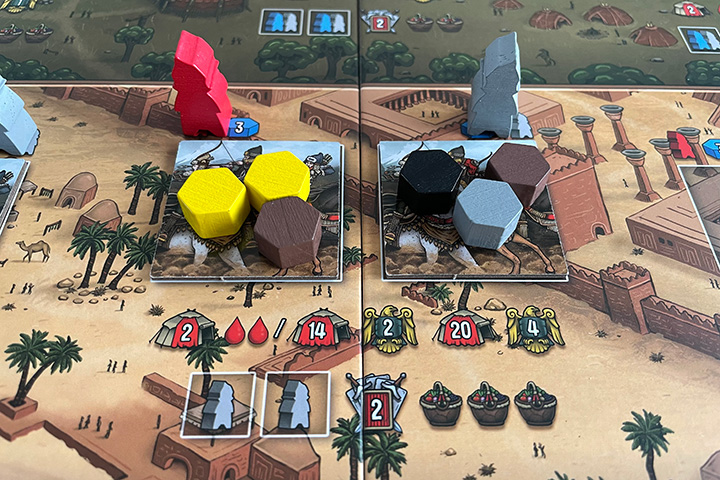
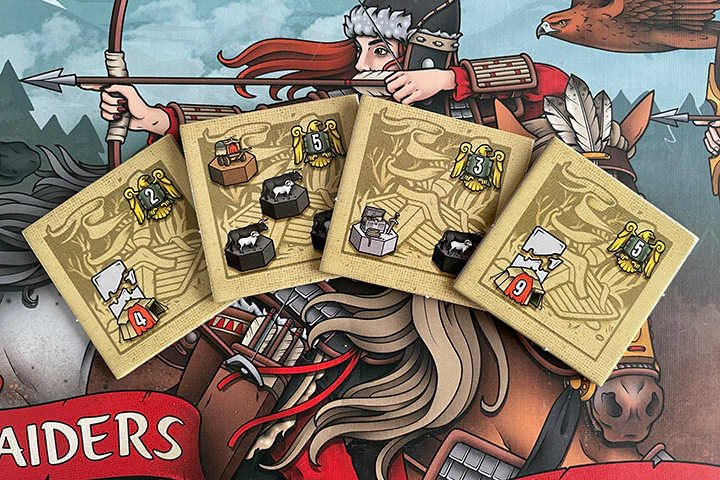
Once there are only either two raids or two quests left, the current round is finished and a final round is played. At the end the player with the most victory points wins.
How does the AI work?
The AI in Raiders of Scythia uses an automa deck. At the start of the AI’s turn you flip a card. Every card shows two things: the settlement it wants to raid and the worker placement action it will block during your next turn.
The part that explains which settlement the AI wants to raid is divided into two columns that you read from top to bottom. The left column explains what it wants to do and what it needs, the right column shows what the AI will fall back to if it fails the requirement on the left.
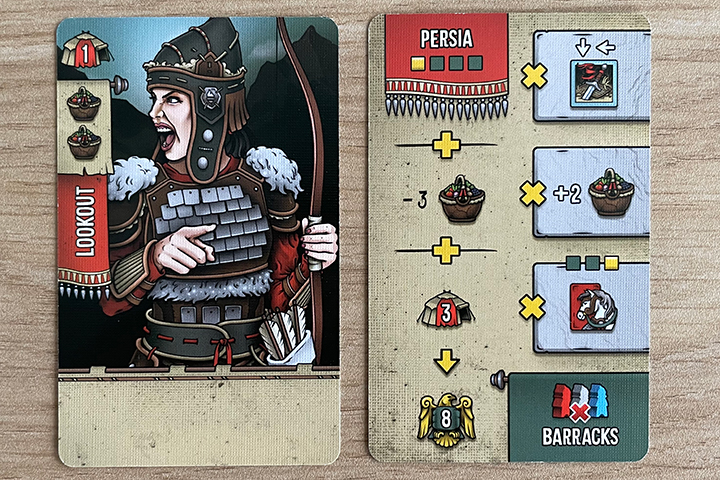
An example based on the picture above. In the top left it says it wants to raid in Persia. If there are no available raiding spots in Persia you stop right there and execute the fallback in the top right. In this case that means it tries to complete an available quest. If there is an available raiding spot in Persia however, you continue downwards on the card. There you will see the requirement for the provisions. Does the AI have three provisions to spend? If not, look at the fallback to the right, in this case that means it takes two provisions and that’s it for its turn. If it does have the provisions, you look at the AI strength. Does it have at least three strength? If not, look at the fallback to the right, in this case that means it takes a horse (the AI uses horse cards to determine its strength) and that’s it for its turn. If it does have enough provisions and strength, it has everything it requires to raid and it discards the required amount of provisions and strength (horses) and gains the indicated amount of victory points.
When the AI raids a settlement all the plunder on it gets discarded, but the quest tile does get flipped and becomes available to both you and the AI to complete.
So basically on every turn the AI is either gaining provisions, gaining strength, discarding provisions and strength in order to raid a settlement or completing a quest. This is exactly what a real player would do. “Can I raid? No? Ok, what do I need to do to become stronger so I can raid in the future?”
The AI comes in four difficulties. Each difficulty has a base strength and a starting amount of provisions. The Trader starts with one provision and has no base strength, so all his strength will need to come from horses. The Lookout starts with two provisions and has a base strength of one. The Huntsman is similar to the lookout, but whenever she gains two provisions, she gains an extra one. The Outrider starts with three provisions and has a base strength of two. Just like the huntsman, she gets an extra provision whenever she gains two.
These seem like minor differences, but they have quite an impact on their scoring capabilities.
What does it look and feel like?
Everything in the box is of a very good quality. The cards have a nice linen finish, the provisions and kumis are made out of wood and custom shaped, the cardboard quest tiles are quite thick and sturdy. The dice feel somewhat heavy and have a really nice swirly finish in them. These are probably my favorite parts of the game, visually.
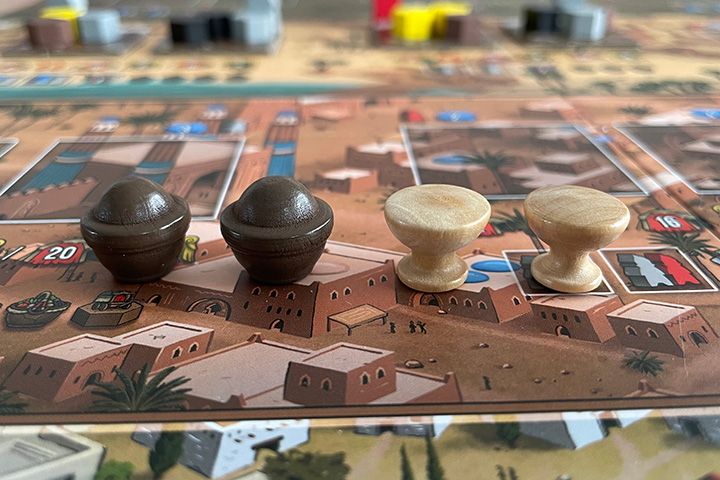

I’ve read some complaints about gold, equipment, wagons and livestock all having the same shape and how distinct shapes would have been nicer. Of course, when you have to grab random plunder from a cloth bag, you don’t want to be able to feel the difference between them. So them being the same shape makes sense and doesn’t bother me at all.
The artwork is done by Sam Phillips and I genuinely like his style. The iconography is very clear and nicely dope. The game board is filled with tiny little details without making things feel too crowded or overwhelming.
Everything in this game is a joy to hold and look at.
How much time does it take?
The setup of Raiders of Scythia is pretty straightforward. Shuffle a few decks of cards, shuffle the quest tiles and place 14 face down on the game board, grab two to four random plunder and place them on every raid spot. That’s it.
I’m not a huge fan of storing cards in plastic bags, so I got myself the Folded Space insert. This helps a bit with the setup and teardown and brings both down to less than five minutes. If you keep everything in the bags that came with the game, I would guess setup and teardown would take you about five minutes each.
At about 12 or 13 games in, I think a game takes me about an hour. Let’s say around 70-75 minutes including setup and teardown. I do tend to overthink my actions, so it might be less for you.
What is my verdict?
I don’t think there is anything about this game that I don’t like.
The combination of the place-a-worker-take-a-worker mechanic with the different types of workers really works for me. The concept is so simple but the effect it has is super fun and interesting.
I like how there are 38 unique crew cards (there are 76 in total) and how their abilities can change the way you approach raids and make every game just a bit different. Using eagles to improve the passive abilities and make the active ones usable is a very clever idea and having a card contain a horse and an eagle makes for some difficult choices. Do you take that card for the horse with three strength, or do you take it for the eagle that will allow the Brawler to reroll two dice per raid instead of just one?

I love the AI in this game. It feels like you’re playing against a human opponent and the four levels of difficulty provide more than enough challenge.
At the time of writing Raiders of Scythia is my favorite game and I don’t expect it to leave my top five anytime soon.
Score
To make things easier for myself, I use the same scoring categories Board Game Geek uses.
Comments
I'm sorry, I don't support comments on my website. If you want to discuss the game or my review, feel free comment on this dedicated Instagram post or my review on BGG.